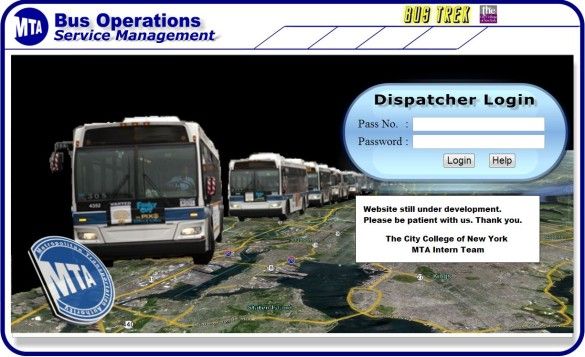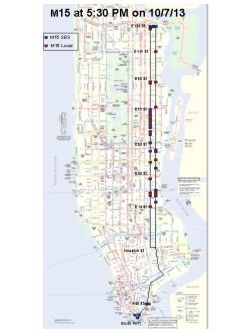The Commute: Bus Time And Bus Bunching

THE COMMUTE: The MTA has always denied that bus bunching is a major problem. The party line has been that it is caused by traffic, is unavoidable, and little can be done to prevent it. The truth is that bus bunching occurs even on routes with light traffic that are scheduled to operate every 20 minutes, such as the B4, increasing the wait to 40 minutes. When I designed the B4 loop around Sheepshead Bay station in 1978, it was my hope that when two buses would arrive at once, the bus that was late would transfer passengers bound for the loop to the following bus and go straight along Emmons Avenue, thereby saving 10 minutes. However, I have seen two B4 buses follow each other around the station, with no action taken to help maintain the schedule.
Riding buses in New York City is a crapshoot. When the system works, it works well. When it doesn’t, bus trips take forever. There is no in-between. It has been my experience that between one-third to one-half of the time, a bus trip will involve a major delay. Subway riders, on the other hand, experience major subway delays no more often than once a week (excluding reroutes due to track work). Much more needs to be done to increase bus reliability.
Last February, I wrote about Bus Time, the new system the MTA is deploying to let riders know on their smartphones or computer when the next bus will arrive. Well, not exactly when they will arrive, but how far away the next bus is. The system has been implemented in the Bronx and Staten Island for a while, and made its debut in Manhattan two weeks ago.
Time will tell how effective Bus Time will be in reducing bus bunching. One thing is for certain: the MTA will no longer be able to deny how widespread the problem is, and hopefully will be pressured by the public to do something about it.
The day Bus Time debuted in Manhattan, I was curious to find out how the M15 was performing since I have heard both favorable and unfavorable stories regarding the M15 SBS, a route I have never taken. According to the MTA’s first-year progress report, 99 percent of M15 SBS riders are satisfied with the service.
The exclusive bus lanes on First and Second Avenue were supposed to reduce bus bunching, and the MTA is looking toward SBS as a means of increasing reliability on other routes throughout the city. However, is the M15 more reliable today since SBS appeared on the M15 three years ago?
l looked up the locations of the M15 SBS and M15 local buses at about 5:30 p.m. on Monday,October 7, and mapped them on a single map. I wanted to see if passengers would have to bypass locals because they already purchased fares for the SBS, and how long they had to wait for a bus. Based on what I found, it seems impossible that the MTA’s survey of 99 percent satisfaction could be at all accurate.
The amount of bus bunching I saw at that time on both the SBS and the local was astounding. Six SBS buses were waiting at the terminals. Thirteen were operating southbound, seven of them within two miles, and only six going northbound. There were no buses, either express or local, moving in either direction south of East 23 Street, with the exception of one northbound bus and one southbound bus at Wall Street. I do not know if this was an anomaly or a typical situation. Below is a map:

The map shows two large gaps in bus service, which I estimate to be about 30 to 45 minutes. The gaps inclue one southbound and the other northbound, between Wall Street and East 14th Street or East 23rd Street. If you were lucky enough to board a bus where they were clustered, southbound between East 79th Street and East 59th Street, or where you only had to wait about five minutes for an SBS bus, you probably had a favorable opinion of SBS. Not so if you were affected by one of the major service gaps.
Bus Time is a definite asset to the system, especially if it can be used to help drivers keep on schedule. It would have been better if it were also available at bus shelters for those without smartphones or access to a computer.
What Bus Time Will Not Do
It will not tell you if the bus will skip your stop if it is too crowded, or if the operator will not stop if he is running late as happened to me once again on October 8 while waiting for the B1 at Falmouth Street. The bus was due at 8:20 a.m. I arrived at the stop at 8:16 a.m. The bus, with only a handful of passengers, was only two minutes late. Apparently either a dispatcher or the operator thought it would be better if he bypassed the first few stops to regain those two minutes since it would be more difficult to regain them later.
Perhaps it was the correct decision to inconvenience a few to help many more. The next B1 bus arrived four minutes early, hopefully intentionally, because he knew the bus ahead of him did not stop. (I say early and not six minutes late because he was driving way too slow to be late.)
So that is not what bothered me. What annoyed me was that during the four extra minutes I waited, four “Not in Service” buses passed. Why should the MTA operate so many Not in Service buses when it knows buses are either overcrowded or skipping stops to maintain a schedule? More Not in Service buses need to be scheduled to pick up passengers on their way to and from the depot, especially when overcrowded buses are not stopping. Years ago, non-revenue mileage was considered unproductive miles, and it was kept at a minimum.
Today, management believes it is more efficient to operate buses without passengers than with them. The assumption is that the current headways are adequate and everyone will just wait for an in-service bus, so no revenue is lost. Operating buses not in service when leaving or returning to the depot saves five or 10 minutes of bus operator time. Inconvenience to the passenger who may have to wait an additional five or 10 minutes more during bad weather, in addition to their normal wait, is not a consideration.
Had I just missed the previous bus, if it was on time and did stop and the next bus was not early, I would have had to wait 19 minutes, which is not acceptable for a heavily utilized route in the heart of rush hour.
I can hardly wait until Bus Time comes to Brooklyn, now scheduled for 2014. We will be able to see for the first time where all those B36 buses are that Sheepshead Bites readers continue to complain about. If bus drivers are indeed playing games, it will now be apparent to management so that appropriate action can be taken. Hopefully, with Bus Time, bus reliability, the bus passengers’ number one complaint, will be improved and bus bunching will be reduced.
The Commute is a weekly feature highlighting news and information about the city’s mass transit system and transportation infrastructure. It is written by Allan Rosen, a Manhattan Beach resident and former Director of MTA / NYC Transit Bus Planning (1981).
Disclaimer: The above is an opinion column and may not represent the thoughts or position of Sheepshead Bites. Based upon their expertise in their respective fields, our columnists are responsible for fact-checking their own work, and their submissions are edited only for length, grammar and clarity. If you would like to submit an opinion piece or become a regularly featured contributor, please e-mail nberke [at] sheepsheadbites [dot] com.




